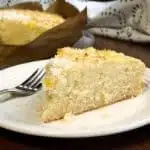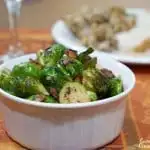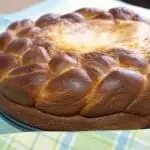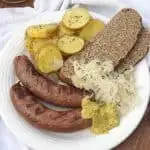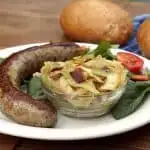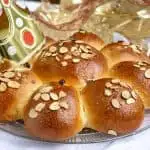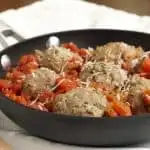Vietnamese fried spring rolls (Cha Gio) may be less well known than their Chinese counterparts, but they are just as delicious. Crisp on the outside, with a tasty filling; they’re perfect dipped in the traditional nuoc cham as well.
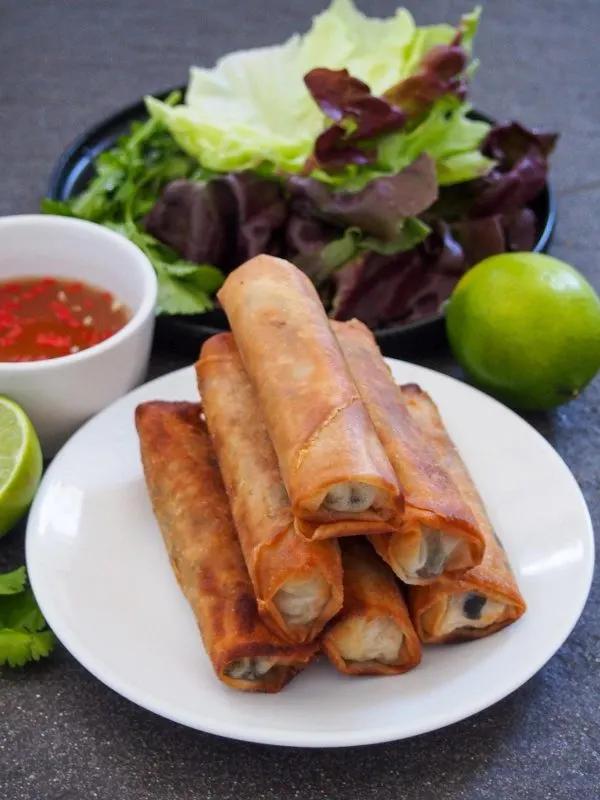
Soft vs crispy Vietnamese spring rolls
When you think of Vietnamese spring rolls, you almost certainly think of the fresh spring rolls made with rice paper, goi cuon.
Sometimes called summer rolls, you can recognize these by their soft outside, with their fillings such as shrimp and herbs faintly showing through the semi-translucent wrappers.
(The rice paper wrapping is not cooked, simply dipped in water to soften it.)
Crispy spring rolls, cha gio, on the other hand, are typically fried and served with a light fish sauce-based dipping sauce.
You can also bake them, though it is not as traditional and they don’t tend to crisp as well.
Wheat or rice paper wrappers?
Cha gio are traditionally made with rice paper wrappers, just like the summer rolls. But, using thin, wheat-based wrappers is becoming more common.
The wheat wrappers, the same that you use for Chinese spring rolls, crisp up better and tend to have less issues with the filling escaping.
You also don’t need to soften them before forming the rolls.
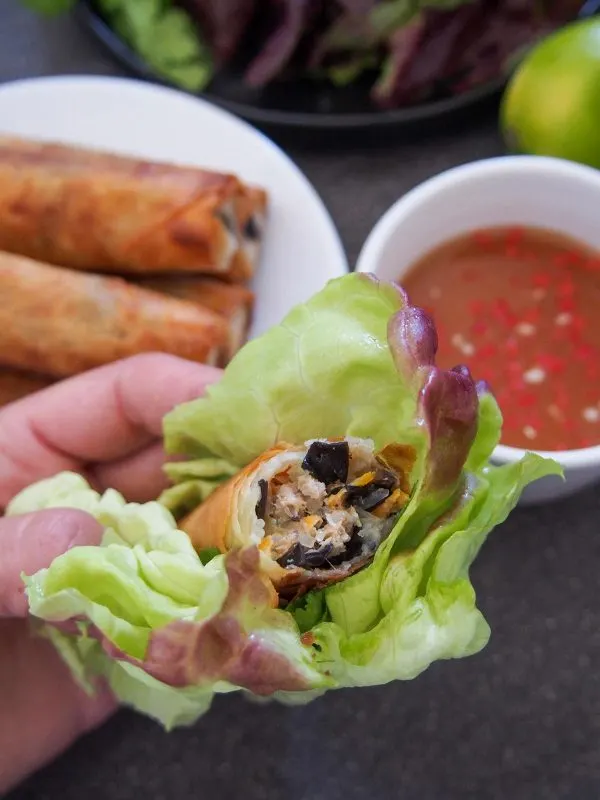
How to serve cha gio
These rolls are typically served as an appetizer, often alongside other small plates of food. Although you can also serve them on their own.
Another way to serve them is cut in half on top of a salad.
You can eat them just as they are, with nuoc cham dipping sauce on the side. But, a popular way to eat them is wrapped in lettuce, often with herbs tucked in there as well, before dipping.
What is nuoc cham?
Nuoc cham is a popular condiment in Vietnamese cooking made with lime and fish sauce. The exact ingredients can vary depending on the intended use.
It’s mainly used for dipping, such as for bun cha Hanoi and with some meat and rice dishes.
It can also be used as a salad dressing or marinade.
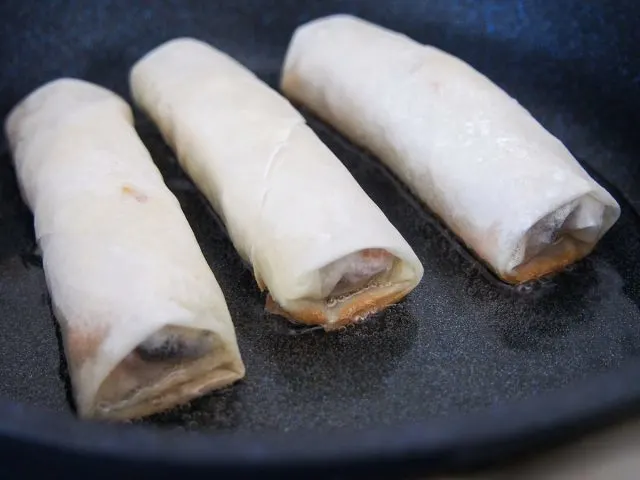
Tet nguyen dan – Vietnamese New Year
While not one of the foods that you’ll find exclusively for the celebrations, these Vietnamese fried spring rolls are something you might likely see served to guests during the Vietnamese New Year.
Tết Nguyên Đán (節元旦), which is Sino-Vietnamese for “Feast of the First Morning of the First Day” is the Vietnamese celebration of the Lunar New Year.
The name is often shortened to “Tet”.
Is the Vietnamese New Year the same as the Chinese New Year?
Since both follow the Lunar New year, the timing of the Vietnamese New Year is the same as the Chinese New Year.
Some of the aspects of the celebrations are very similar:
- For both, the celebration is seen as the start of spring and establishing luck for the year ahead.
- Red and yellow are viewed as lucky colors, and you’ll find them as part of the Tet celebrations.
- Families typically travel home to be with relatives.
- Red envelopes with money are given to children.
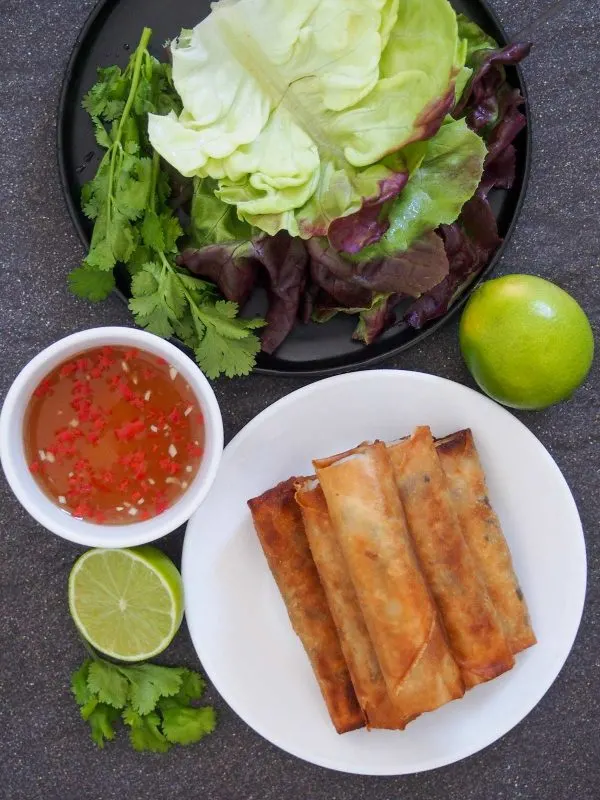
But, there are some differences as well.
How do the Vietnamese celebrate Tet?
The myth associated with Chinese New Year is not a part of the Vietnamese traditions. Instead, it is simply the start of the agrarian calendar in terms of planting for the next year’s harvest.
The celebrations tend to be shorter and instead of lanterns and cut outs as decoration, flowers are much more prominent.
In Northern Vietnam, peach blossoms are displayed around the home, while in the South, apricot blossoms are more popular. Both flowers are considered to bring prosperity and fortune.
People also use other flowers such as chrysanthemums to decorate their homes.
Many of the foods eaten for Chinese New Year celebrations are chosen as they are believed to bring luck and prosperity, such as steamed fish, dumplings and noodles. However the foods for Tet don’t have that same significance.
Even banh chung, which is always served on the first night of Tet and really only eaten during this time, is more about the experience of sharing it with family and reflecting on ancestors who gave the distinct flavors to their version.
Whether as part of a Tet celebration or not, though, these spring rolls are definitely worth trying.
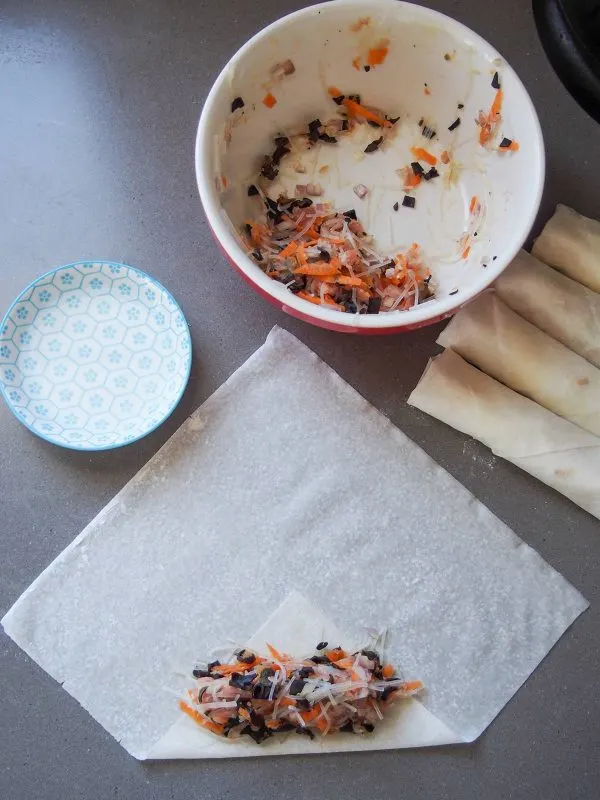
Differences between Chinese and Vietnamese spring rolls
As mentioned above, these Vietnamese rolls are traditionally made with rice paper wrappers, although thin wheat wrappers, as used with Chinese spring rolls (not the thicker ones used for egg rolls), is becoming more popular.
While both typically use pork in the filling, the other ingredients often differ.
Chinese spring rolls usually include pork along with cabbage and often bean sprouts or bamboo shoots. They can also be purely vegetables. Oyster sauce is often part of the seasoning.
Vietnamese rolls, meanwhile, include broken up mung bean vermicelli noodles and mushrooms, typically wood ear mushrooms along with the pork and, sometimes, shrimp.
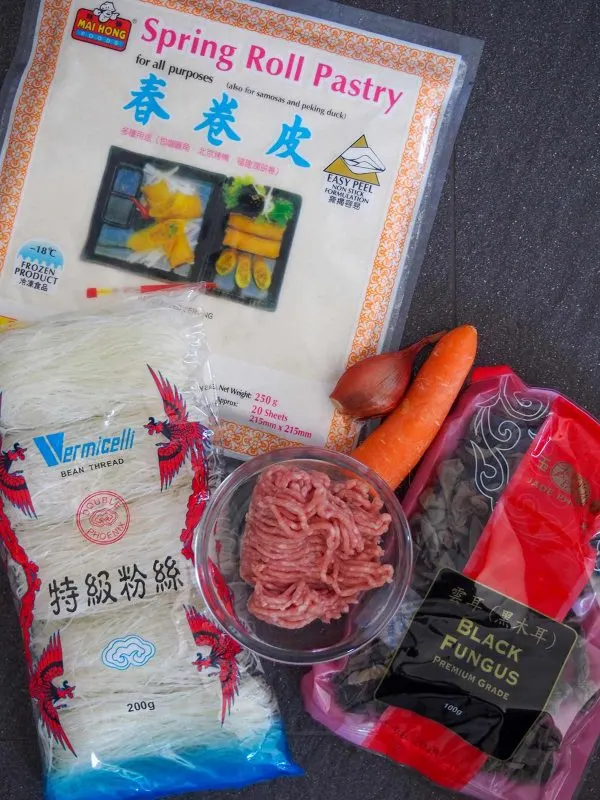
Whether as part of a celebration with family and friends, as an appetizer or snack, there’s no doubt these Vietnamese fried spring rolls are a delicious dish to enjoy.
The fillings are relatively simple but work so well, especially with the dipping sauce on the side.
So get rolling, and give them a go!
Cha Gio (Vietnamese Fried Spring Rolls)
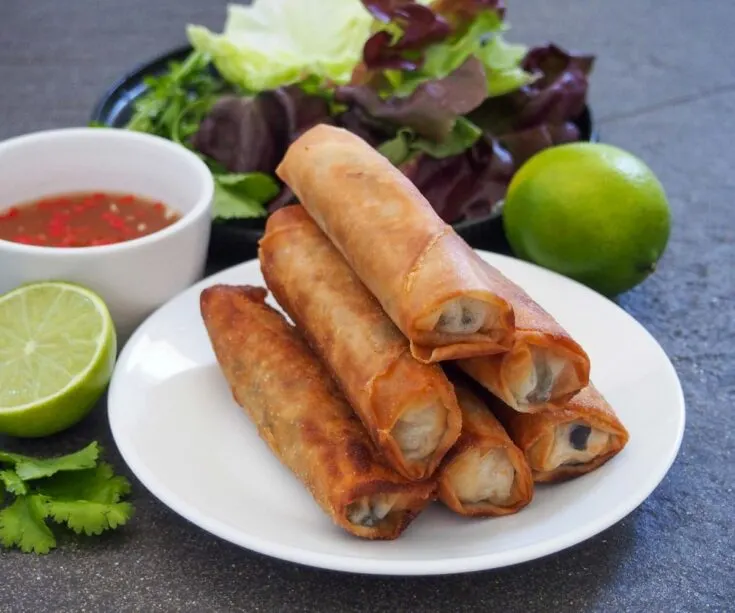
Vietnamese fried spring rolls (Cha Gio) may be less well known than their Chinese counterparts, but they are just as delicious.
Ingredients
- 1/4 cup (1/2oz) dried wood ear mushroom*
- 1 oz dried vermicelli noodles (traditionally mung bean, also called cellophane noodles)
- 2 shallots
- 1 carrot
- 1/2 lb ground pork
- 1/2 tsp salt
- 1/2 tsp pepper
- 1/2 tsp sugar
- 12 spring roll wrappers
- 1/2 cup soybean oil/canola oil to cook (more as needed)
Instructions
- Place the wood ear mushrooms and vermicelli noodles in separate small bowls and cover both with hot water. Leave each to sit until the mushrooms expand and the noodles become white, around 5-10 minutes for each. Drain both and chop the mushrooms finely and the noodles into small lengths.
- As the mushrooms and noodles are soaking, finely chop the shallots and peel and grate the carrot.
- Mix together the ground pork, chopped mushrooms, chopped noodles, chopped shallots, grated carrot, salt, pepper and sugar. Use your hands if necessary to mix well (they may not all completely stick together but that's fine). Divide the mixture into 12 relatively equal portions.
- Lay one spring roll wrapper on a clean surface with a corner pointing towards you. Have a small bowl of water ready next to you. Fold over the nearest corner of the wrapper inwards to almost the middle of the wrapper and then put one portion of the filling on top in a small log cross-wise near the folded edge.
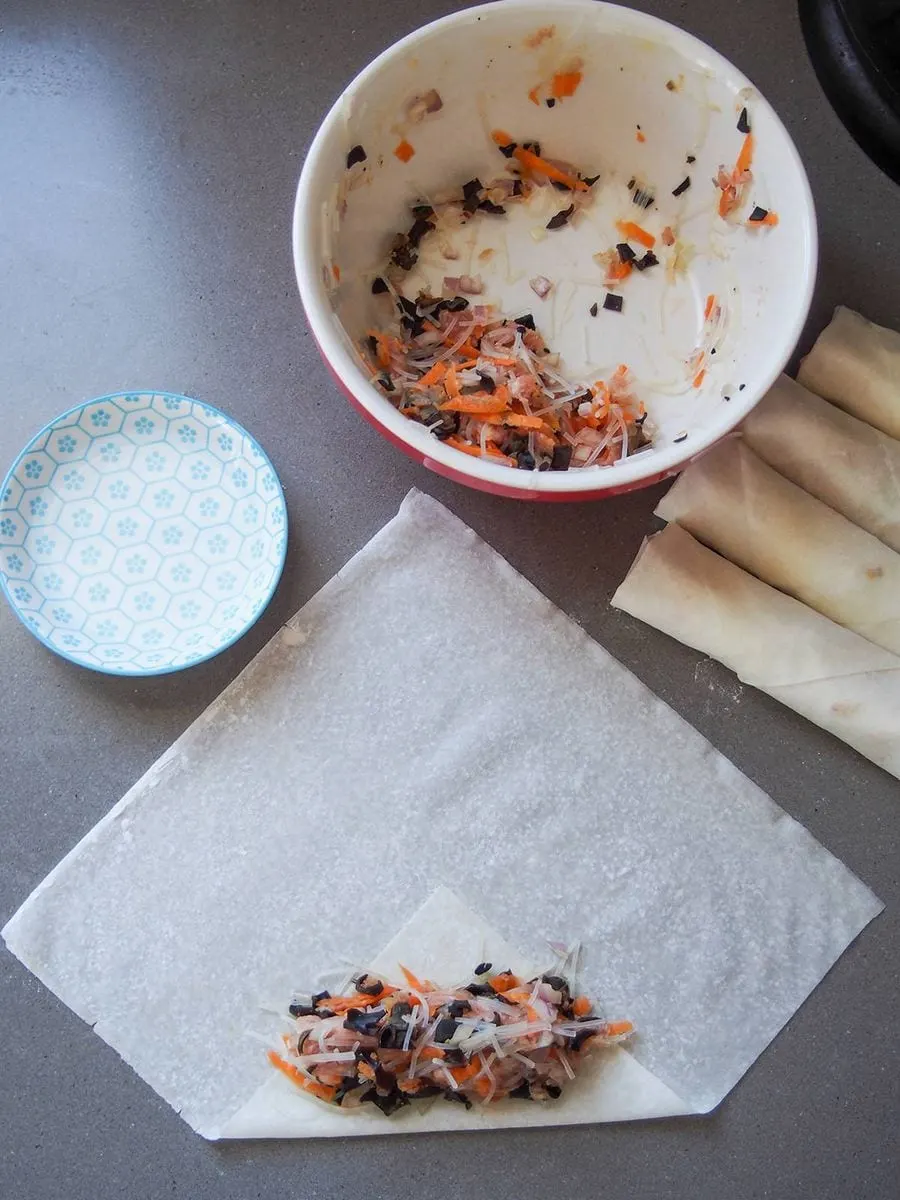
- Fold in both sides to just be covering the ends of the log and so the folds formed are parallel with each other. Fold the front, folded edge over the filling, making sure the sides stay folded in to avoid the filling from escaping, and keep rolling up until only a triangle is left. Try to avoid having much air inside as you roll.
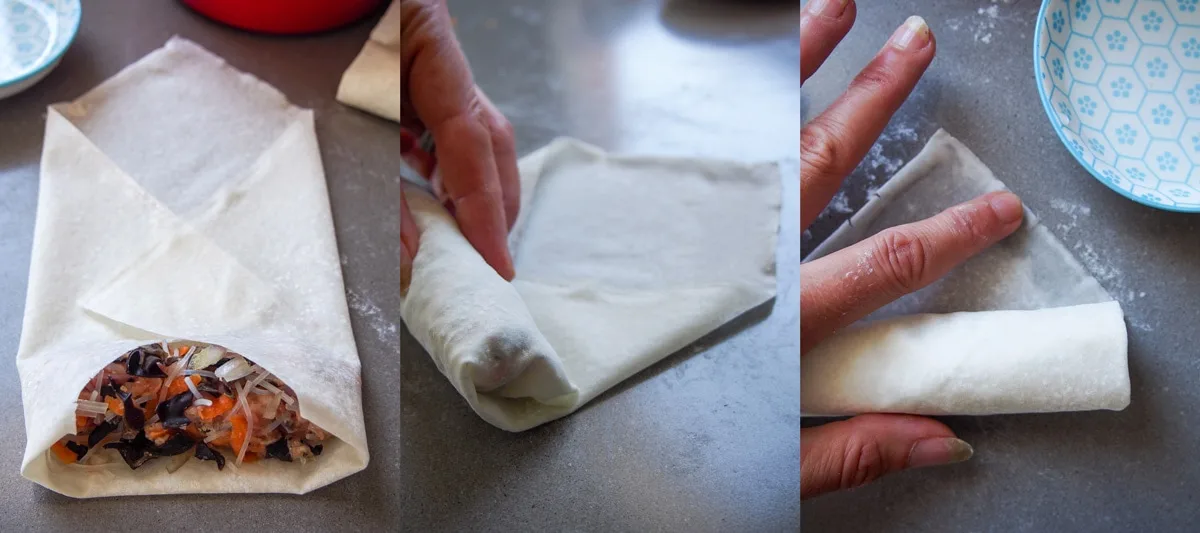
- Dampen the tip of your finger and moisten the edges of the remaining triangle of the wrapper then keep rolling so that the end of the wrapper sticks flat onto the roll. Repeat with the rest of the wrappers and filling.
- Warm the oil in a skillet over a medium-high heat (you can either do a few at a time in a smaller skillet or cook more in a larger skillet - it will be quicker with more at a time but, easier to turn before they cook too much if cooking smaller batches).**
- Add the rolls to the hot oil and cook for around 2-3 minutes on each side until they are golden all over. Remove from the skillet and drain on a kitchen paper towel.
- Repeat to cook the rest of the rolls, topping up the oil as needed.
Notes
*Wood ear mushrooms are also sometimes called black fungus. Both these and the noodles can be found in many large supermarkets, as well as Asian supermarkets.
**Traditionally, these are cooked in a wok-style pan and more deep fried, which you can do if you prefer. Just use a larger quantity of oil if you do, and you will probably only need to turn once. If more shallow frying, as described above, you just need a thin layer of oil in the skillet and you may need to turn the rolls two or three times to get all sides.
Recommended Products
As an Amazon Associate and member of other affiliate programs, We earn from qualifying purchases.
Nutrition Information:
Yield:
12Serving Size:
1 rollAmount Per Serving: Calories: 194
If you liked this recipe, here are some similar dishes you may enjoy!

Caroline lived and traveled various places before settling in Cambridge, MA. She still fits in some travel with her family, but often settles for traveling through food instead. She shares her recipes at CarolinesCooking.com, where there’s plenty of international inspiration using seasonal ingredients, as well as creative recipes for all to enjoy. Caroline is originally from Scotland, where she grew up hiking and skiing, both things she still loves to do when her two young boys give her a chance. You can follow along with her cooking adventures on Facebook, Instagram, Twitter, and Pinterest.


